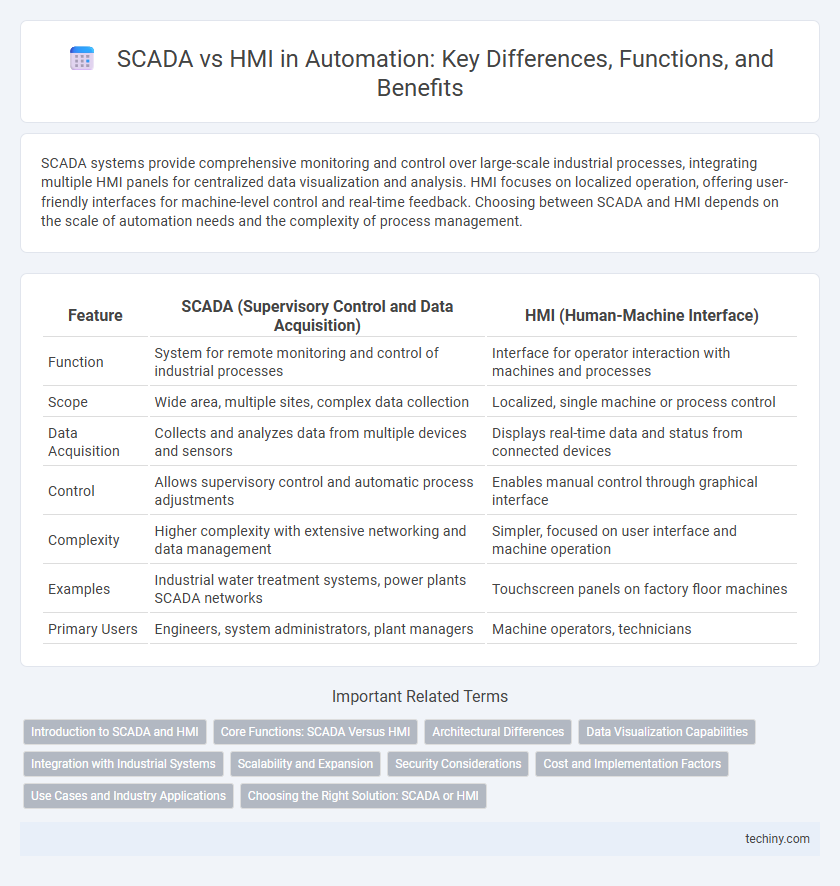SCADA systems provide comprehensive monitoring and control over large-scale industrial processes, integrating multiple HMI panels for centralized data visualization and analysis. HMI focuses on localized operation, offering user-friendly interfaces for machine-level control and real-time feedback. Choosing between SCADA and HMI depends on the scale of automation needs and the complexity of process management.
Table of Comparison
| Feature | SCADA (Supervisory Control and Data Acquisition) | HMI (Human-Machine Interface) |
|---|---|---|
| Function | System for remote monitoring and control of industrial processes | Interface for operator interaction with machines and processes |
| Scope | Wide area, multiple sites, complex data collection | Localized, single machine or process control |
| Data Acquisition | Collects and analyzes data from multiple devices and sensors | Displays real-time data and status from connected devices |
| Control | Allows supervisory control and automatic process adjustments | Enables manual control through graphical interface |
| Complexity | Higher complexity with extensive networking and data management | Simpler, focused on user interface and machine operation |
| Examples | Industrial water treatment systems, power plants SCADA networks | Touchscreen panels on factory floor machines |
| Primary Users | Engineers, system administrators, plant managers | Machine operators, technicians |
Introduction to SCADA and HMI
SCADA (Supervisory Control and Data Acquisition) systems provide centralized monitoring and control over industrial processes by collecting real-time data from multiple field devices and sensors. HMI (Human-Machine Interface) serves as the user interface, allowing operators to interact with machines through graphical displays and input controls. Together, SCADA manages data acquisition and system control, while HMI facilitates operator visualization and command execution.
Core Functions: SCADA Versus HMI
SCADA systems provide centralized monitoring and control of entire industrial processes by collecting real-time data from distributed sensors and devices, enabling comprehensive system-wide analysis and remote operations. HMI interfaces focus on localized control and visualization, allowing operators to interact directly with specific machines or equipment through graphical displays and input devices. Core functionality differences highlight SCADA's role in supervisory control and data acquisition across multiple locations, while HMI serves as the operator's direct interface for machine-level management.
Architectural Differences
SCADA systems encompass a comprehensive architecture that integrates multiple HMI units, remote terminal units (RTUs), and programmable logic controllers (PLCs) to enable centralized monitoring and control across large-scale industrial processes. HMIs serve as localized interfaces that provide real-time data visualization and operator interaction within a single machine or process, focusing on human-machine interaction without the extensive networked infrastructure. The architectural difference lies in SCADA's hierarchical networked design enabling system-wide data aggregation and control, while HMI architecture is typically standalone or limited to direct device communication.
Data Visualization Capabilities
SCADA systems offer comprehensive data visualization capabilities by integrating real-time data from multiple remote devices across large industrial networks, enabling detailed system-wide monitoring and control. HMI provides localized data visualization focused on individual machines or processes, delivering intuitive graphical interfaces for immediate operator interaction. The scalability and depth of data visualization in SCADA surpass HMI by combining data acquisition, processing, and centralized display for enhanced decision-making in complex industrial environments.
Integration with Industrial Systems
SCADA systems offer comprehensive integration with industrial processes, enabling real-time data acquisition, centralized control, and system-wide monitoring across multiple locations. HMIs primarily provide localized operator interfaces for machine-level control, often requiring SCADA systems or PLCs for broader data aggregation and supervisory management. Effective integration of SCADA and HMI ensures seamless communication between field devices, controllers, and enterprise systems, optimizing operational efficiency and decision-making.
Scalability and Expansion
SCADA systems offer superior scalability for large-scale industrial automation by integrating numerous remote sites and extensive data points, enabling centralized control across vast operations. HMI solutions excel in localized visualization and control but are limited in handling multi-site expansion without additional SCADA infrastructure. Leveraging SCADA enhances expansion capabilities, supporting complex, distributed networks with robust data acquisition and comprehensive system management.
Security Considerations
SCADA systems often face higher security risks due to their extensive network connections and critical infrastructure control, requiring robust encryption and multi-layered defense strategies. HMI interfaces, while generally localized, must implement stringent access controls and authentication protocols to prevent unauthorized manipulation. Both SCADA and HMI security frameworks should include regular software updates and real-time monitoring to mitigate cyber threats effectively.
Cost and Implementation Factors
SCADA systems often involve higher initial costs due to extensive infrastructure and centralized control requirements, while HMI solutions typically have lower upfront expenses with simpler installation. Implementation of SCADA demands skilled personnel and longer setup times for network integration and data acquisition, whereas HMI can be rapidly deployed with minimal training for local machine control. Choosing between SCADA and HMI depends on project scale, complexity, and budget constraints for automation control and monitoring.
Use Cases and Industry Applications
SCADA systems excel in large-scale industrial automation by enabling centralized monitoring and control across multiple sites such as oil and gas pipelines, water treatment plants, and power generation facilities. HMI interfaces are best suited for localized machine control and operator interaction in manufacturing lines, packaging, food processing, and automotive assembly plants. SCADA provides extensive real-time data collection and remote access capabilities, while HMI offers intuitive visualizations tailored to on-site operators for immediate machine-level adjustments.
Choosing the Right Solution: SCADA or HMI
Selecting between SCADA and HMI depends on the complexity and scale of the automation system. SCADA systems excel in monitoring and controlling large-scale industrial processes with distributed assets, offering extensive data acquisition, analysis, and remote control capabilities. HMI interfaces are best suited for localized control and visualization, providing operators with real-time system status and simplified interaction in single-site applications.
SCADA vs HMI Infographic

 techiny.com
techiny.com